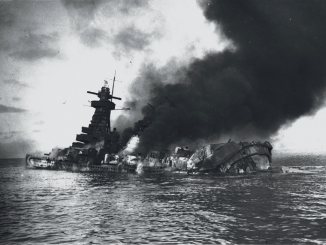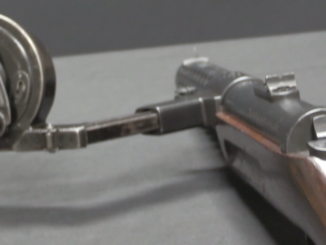(Note: this rifle was removed from the auction, so I have no link to provide for it)
I have been unable to find any history on this particular rifle, which is an experimental mixture of parts, including a bayonet lug and a sporter-style rear sight on a 7x57mm 1893 model Mauser action. What is interesting about it, though, it the automatic muzzle cover connected to the trigger. The front sight is mounted to a spring-loaded muzzle cover, which lifts up as the trigger is pulled. Once the trigger is just ready to fire, the front sight is fully elevated into position for a proper sight picture. It’s pretty clear why this really interesting idea didn’t make it into production…




“What is interesting about it, though, it the automatic muzzle cover connected to the trigger.”
First prototype of KV-2 assault tank also have muzzle cover (see 4rd image from top):
http://www.tanks-encyclopedia.com/ww2/soviet/soviet_KV-2.php
it was considered, and its design proved to be flawed and was abandoned
The two-position rear sight would seem less “sporting” than military. the sort you’d use for a rough sight picture at CQB range, like the “L” flipover sight on the early M1 .30 Carbine or No.4 0.303in rifle. the pistol-type front sight also implies use at under 200 meters. I suspect the rear sight settings are 50 and 100 meters.
A muzzle cover intended to be watertight would have a rubber seal, which this doesn’t seem to possess. Unless that “hole” in the underside was intended to hold a “plug” rather like a foam earplug shape that was inserted into the muzzle as the lid was closed by its spring. (I see no other reasonable function for that hole, actually.)
With such a seal, I’d be inclined to suspect a weapon intended for a combat swimmer. If indeed they had such things back then.
The rifle has either seen some serious use, bee dismantled a few times, or both. Note the chip out of the handguard just behind the front sight assembly.
All in all, a rather odd piece of machinery.
cheers
eon
We could be looking at a carbine with dashed hopes for use during amphibious assaults. Yes, the barrel would be free of clogging prior to the user commencing festivities. The trigger pull however is a bit creepy and impractical since the trigger must first clear the muzzle before discharging. As a result, accuracy and muzzle cap integrity would be sacrificed if one were to operate the rifle with a panicky jerk pull. I mean, seriously, unless one is planning an assassination with the intended victim less than 200 meters from a river bank or rocky beach, how does the automatic muzzle cap make any sense?
Was then standard 7×57 cartridges water-proof or not?
Most mind-boggling is why to put sight on cover, when you can attach it positively to barrel?
I think it is either technology demonstrator or proof of concept or maybe someone bachelor thesis or just simply thing made to cause people to ask “was it is?”
Well, it appears to be more of a demonstrator. The front sight was likely put on the cover because the original sight would have impeded the cover’s operation.
The right side of the forward receiver ring has grinding marks. Possibly where the serial number was? Looks to be crude, for anything on a Mauser.
As Col. Klink would say: “Very interestink”!!
Considering the popularity of the rifle/caliber combination in Central and South America, I lean towards this as being the likely origin. As for the purpose, it seems like it could be some prototype “alpine rifle” with the length, pared down bolt, etc. (Peruvian, Chilean, perhaps?) The muzzle cover would serve to keep ice/snow/mud form the barrel right up until it was needed, especially if standing muzzle-up on sentry duty while dug in on a snowy mountain pass. All in all, it’s amazing how much cool stuff is coming to light recently. Unfortunately, I’m afraid the economy may have something to do with a lot of these rare and unusual items showing up at auction. A couple of collectors that I am friends with have been “thinning the herd” recently, and, as much as I enjoy collecting, find myself wondering if I have too many things I have little use for other than looking at and shooting once every few years…then I get on the internet and see all kinds of things I would like to add to the collection. I’ll admit that it is an addiction.
“mud form the barrel”
This my reminds one video: https://www.youtube.com/watch?v=yJutO3D_EF8
Dangit, now you’ve made me waste a half an afternoon watching Pvt. SNAFU! I meant to say “from.”
Possible. But Alpenkorps-type work almost demands either a fully-adjustable rear sight, or better yet a telescopic sight with a range-finding setup, and probably some sort of level (spirit or otherwise) to deal with the “false range” problem when you inevitably end up shooting at something that’s significantly higher or lower in elevation than you are.
Back then, instead of 7 x 57, I think I’d have gone for something like 7 x 73B Vom Hofe for this sort of work, just to get a flatter trajectory.
Yes, I know “mountain rifles” are traditionally lightweight and chambered for rounds with lighter recoil; that’s why so many mountain riflemen spend so much time missing.
cheers
eon
“7 x 73B Vom Hofe”
But this will no fit into Mauser Gewehr, on other hand 7×57 is far from borders of this system, cartridge that fits are:
7x64mm is popular hunting cartridge (at least in Europe)
7x66mm SE vom Hofe is probably biggest 7mm which will fit, created in 1955 to copy 7×73 performance but in shorter package, child of .404 Jeffery
Many other caliber created for Mauser Gewehr exist but if you want bullet that goes fast 6.5x68mm is answer
Actually this is not all that weird. “Back in the day,” before we took an over-nighter into the boonies we went to the PX and stocked up on condoms (or sometimes just small balloons which gave the Swabbies a real treat) and Tampex (which caused further comments and speculations amongst our “boat people”). The former were to go over the muzzles to keep out rain, mud, twigs, bugs and etc. and the latter were to go into the holes in case of “job-related injuries” like maybe getting shot or stabbed. Both worked very well for their alternative purposes and this little addition would have served if further developed such as a grip actuator instead of the trigger link making it to where the hand-grip tightening around the wrist of the stock would have lifted the muzzle cover. The front sight would need to be relocated to the barrel or in my case eliminated in favor of the scope. With a bit of training, accidentally shooting with the “gate closed” should not have been a problem. Just my opinion …
As an engineer this is not such a bad idea. However, it was implemented wrong. Whoever came up with this, should have done three things different.
1: Stick with normal sights. Don’t be pulling a trigger without a good target picture! Duh
2: Rotated it 180deg such that it opened downwards. More like a dishwasher door. Better for keeping ground dirt out. Or rather than a flat door they could have used a knife valve or sugar scoop type door.
3: Two stage trigger. Open on the first Click then Boom. The hammer could release the door back shut.
Not being a ground pounding military guy (just a egg head weapons nerd) is FOD still a big concern for small arms?
Bill: “hand-grip tightening around the wrist of the stock would have lifted the muzzle cover”
How about hooking it to the safety?